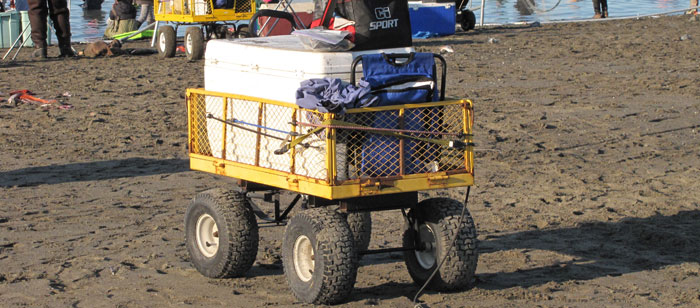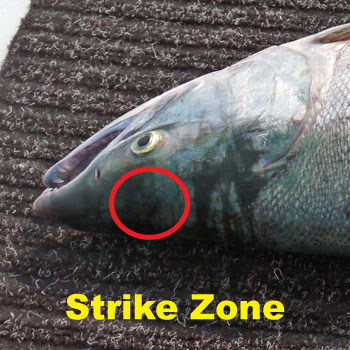Gearing up for Dipnetting in Alaska
While dipnetting is not as expensive as rod-and-reel fishing, there are some basic items you need, in order to be effective. This page contains a list of the basic gear, and some add-ons that will make your trip to the river more pleasant and effective.

The Basics
Here is a list of the basic gear you need in order to dipnet in Alaska. This will be enough to get you started, and you can upgrade or add items from here.
Fishing Regulations
Bring along a current copy of the personal use fishing regulations, so you don't have to guess when it comes to the legal requirements. The Alaska Department of Fish and Game does an excellent job of providing dipnetters with the information they need in order to comply with the regulations. Bring a couple of copies; keep one with you on the river, and the other in your vehicle for safekeeping.
Dipnet Card
You must have a current dipnet card, and a valid sport fishing license in your possession at all times while dipnetting. Your fish must be marked on the card before you leave the fishing area, so bring along a ballpoint pen. The ink from other types of pens will run when it gets wet; ballpoint pens do not.
Dipnet
Dipnets come in all sorts of sizes and lengths. We have reviewed this in detail in our section titled, "Rigging Your Net". When you pack your net for your trip, take time to ensure you have all the hardware and tools needed to assemble the hoop to the handle, and that you have properly secured the net to the hoop. Experienced dipnetters always bring along a spare net. You never know when a component will fail, or when you might lose your net to a rock or a floating log. Bring a spare net! It's also wise to bring along a spare net bag. This is the net itself, which is laced to the hoop. Nets can be torn or otherwise damaged, and without a spare, you're headed home.
It's a good idea to mark your net and pole, so you can distinguish it from other people's gear. Many dipnets look alike, and a little shot of paint can prevent you or someone else from making a mistake.
Legal Requirements
A dipnet may be just about any configuration the user wants, as long as it meets the legal parameters. According to the Alaska Administrative Code (5 AAC 39.105(24)), a dipnet is defined as:
"a bag-shaped net supported on all sides by a rigid frame; the maximum straight-line distance between any two points on the net frame, as measured between any two points on the net frame, as measured through the net opening, may not exceed five feet; the depth of the bag must be at least one-half of the greatest straight-line distance, as measured through the net opening; no portion of the bag may be constructed of webbing that exceeds a stretched measurement of 4.5 inches; the frame must be attached to a single rigid handle and be operated by hand."
Waders
Shore-based dipnetters need hip boots or chest waders in most situations. This allows you to wade out far enough to net fish. Hip boots are the cheapest option, but most people find that chest waders are a far superior tool for giving you the most flexibility of moving to where the fish are. Chest waders are available in several types. Here are the pros and cons of each:
- Neoprene Chest Waders. On the plus side, neoprene waders are relatively cheap, and they insulate your body from the cold temperature of the river. The downside is that they tend to float you off the bottom in deeper water, causing you to lose your footing more frequently. Additionally, holes that develop in neoprene waders are hard to locate and repair.
- Breathable Chest Waders with Molded-in Boots. Without question, breathable chest waders are the best option. The type with the attached wading shoes can work well for you, but they are somewhat limited. For starters, you do not have the ability to change out the wading shoe. You're stuck with what they came with. Next, if a leak develops in the boot, they are very difficult to repair.
- Breathable Chest Waders with Sock-Feet. This is the best option, for several reasons. First, you can choose what wading shoes work best for you. Next, if the waders become damp inside from condensation (this always happens in the neoprene sock foot area), or if you accidentally take a dip in the river, you can completely turn these waders inside-out, including the feet, and get them completely dry. If you're camping out, turn them inside-out when you go to bed, and place the sock feet between your sleeping pad and bag, and they'll be dry by morning.
Always wear a wading belt and a life jacket! If you lose your footing in the river and you're wearing chest waders, air can become trapped in the feet and lower leg area, which can invert you in the water, with life-threatening consequences.
Fish Processing Gear
The whole point of dipnetting is to come up with a large number of fish for food, so it's imperative that you take good care of your catch. This starts with killing and bleeding your fish as soon as possible. The most efficient way of doing this is to bonk the fish on the head with a "fish whacker" and rip out a couple of gill rakers. Each gill raker has an artery running through it, and by ripping or cutting a couple of these, the fish quickly bleeds out.
Be careful to strike the fish above the eyes with your fish whacker. If you hit it too far back, you won't kill the fish, but you will bruise the flesh.
Here is a list of the processing equipment you should have with you:
- Fish bonker
- Kitchen shears (for cutting the tails on your fish)
- Fillet board / table
- Fillet knife (sharp, flexible blade at least 10" in length)
- Fish filleting glove
- 5-gal. plastic bucket
- Bags for fillets
- Ice
- Cooler
Container for Fish
Some dipnetters bring a cooler to the river, and use it for a fish box. Others simply pile their fish up on the beach and backpack them out when they're done, and others may use a damp burlap bag to both cool the fish, and provide a way to carry them from the river. Others may opt for a stringer, which allows them to keep the fish in the river until they're finished for the day. Whatever you decide, you need a container for your fish.
Dress for Success!
Wearing proper attire is important with any Alaska outdoor activity, and dipnetting is no exception. When you pack up for dipnetting, even if it's only for one afternoon of fishing, work from a checklist so you can have a safe, enjoyable experience. Here's a sample list:
- Raingear (you only need the hooded jacket, since you will be wearing waders)
- Ball cap (shades your face from the sun's glare off the water, and keeps the rain off your face)
- Gloves (protects your hands from sharp gill rakers, chafing, and cold)
- Synthetic clothing (synthetics keep you warmer than cotton and dry quickly if you take a dunking)
- Thermal underwear (light-weight with zippered neck)
- Complete change of clothes (if you get wet, you need a dry set of clothes)
River-specific Gear
It should be noted that different fisheries may require items that are different from what is needed elsewhere. For example, if you're fishing from shore in the Copper River, it's common for dipnetters to use shorter poles and to rope off on the rocks, so they don't fall in. The water is swift and deep in the canyon, dipnetters have lost their lives there. On the Kenai and Kasilof rivers, you may want to use a beach cart to haul your gear to the dipnetting area, something that you would not need on the Copper. Review each river's page for specific recommendations.
Need More Information About Alaska Dipnetting?
We've got you covered! Check out the Dipnetting Menu on the left side of this page, or click one of the links below for more information.
Alaska Salmon Run Charts | Dipnetting Intro | Dipnetting Gear | Dipnetting Techniques | Caring for Your Catch
Dipnetting Locations
Check out the following links to the various dipnetting locations in Alaska.
Copper River | Kasilof River | Kenai River | Fish Creek | Susitna River | Twentymile River

